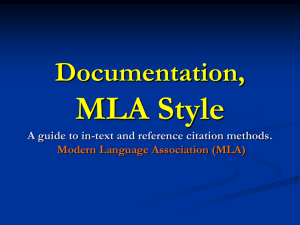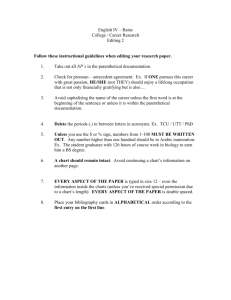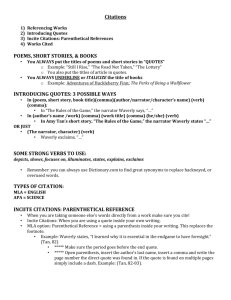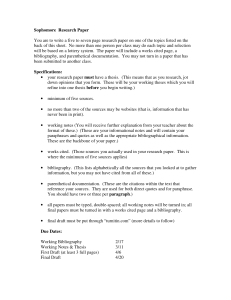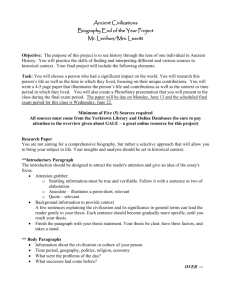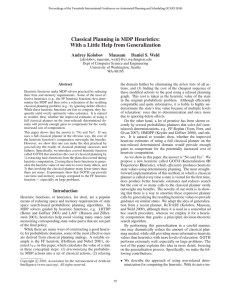MLA STYLE A guide to in-text and reference citation methods.
advertisement
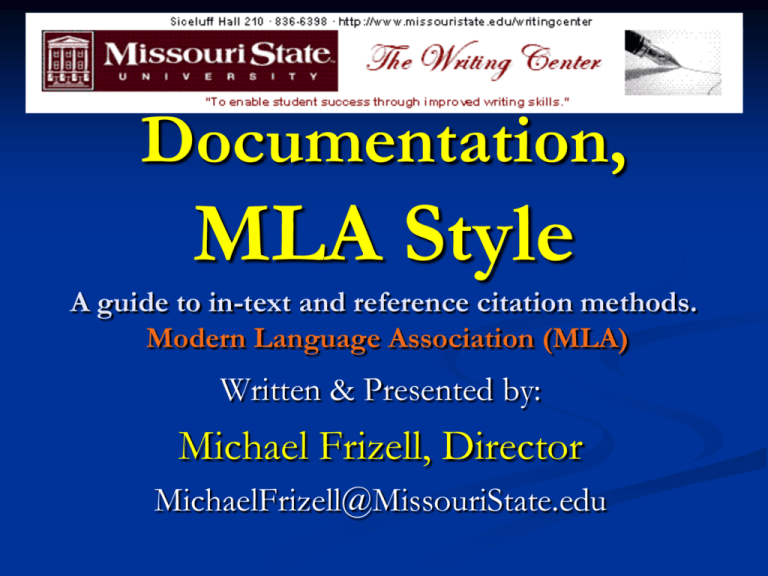
Documentation, MLA Style A guide to in-text and reference citation methods. Modern Language Association (MLA) Written & Presented by: Michael Frizell, Director MichaelFrizell@MissouriState.edu Sources GENERAL RULE: Ideally, no more than 25 percent of your paper should be direct quotations. Paraphrase as much as you can. Use direct quotations when citing a statistic or original theory Use author's words if they capture a point exactly. Parenthetical Citations: Author & Page Number (Keeling 125) Notice there is no “p” and no comma. The struggle for identity is common during puberty (Keeling 125). Parenthetical Citations: Title & Page Number Her distinctive writing style adds to her mystique (“Plath” 19). • Often, articles, editorials, pamphlets, and other materials have no author listed; thus, give the first distinctive word of the title followed by page # Parenthetical Citations: Special Cases Electronic Sources: Articles & Books originally in print – Goth dress can be quite outlandish (Raymon). Other Electronic Sources: You may give the name in parentheses, but you can be more precise and include the name by indicating the format and incorporating the name smoothly into your sentence. Interview or Speech: If the source is an interview, lecture, or speech, include person’s name in introductory clause with no parenthesis: Julia Cohen, graduate student in English and a self-professed Goth, states that being Goth is more a state of mind than outlandish dress. Parenthetical Citations: Multiple Authors Two Sources by the Same Author: Use the first identifying words to indicate the title of the work The radical disconnect in Plath’s writing is evident in the poem Cut (In the Middle, 188). OR (Rimbaud, In the Middle, 188). WORKS CITED List only those sources that you actually used. List the complete title of the article, essay, or book. Alphabetize your list by authors’ last names or the first main word in a title. Online sources usually follow the print format followed by the URL <URL>. (journals, newspapers, magazines, abstracts, books, reviews, scholarly projects or databases, etc.). Format – Author’s last name first Double-space Left Margin Indent second and third lines five spaces Most item separated by periods – leave one space after ending punctuation. Place a period at the end of each entry. WORKS CITED: Specific Entries Book: Author. Title. City: Publisher, date. Corti, Lillian. The Myth of Medea and the Murder of Children. Westport, CT: Greenwood Press, 1998. Article in a Magazine: Author. “Title of Article.” Title of Periodical Date: page(s). Gerard, Jeremy. “Review of Redwood Curtain.” Variety April 5, 1993: p. 43. WORKS CITED: Specific Entries Article in a Newspaper: Author (if given). “Title of Article.” Title of Newspaper Complete date, section number or title: page(s). Kerr, Walter. “The Lives they Lived.” The New York Times 29 December 1996, late ed.: sec. 1: 53. Article or Story in a Collection of Anthology: Author. “Title.” Book Title. Editor. City: Publisher, date. Pages. Franklin, Benjamin. “The Speech of Miss Polly Baker.” Benjamin Franklin: The Autobiography and Other Writings. Ed. Kenneth Silverman. New York: Viking, 1986. 209-213. WORKS CITED: Specific Entries Article in a Scholarly Journal: Author. “Title of Article.” Journal Title Volume number (complete date): pages covered by article. Witham, Barry B. “Images of America.” Theatre Journal 34 (May 1982): 223-232. Encyclopedia “Title of Article.” Title of Encyclopedia. Year of the edition. “Plath, Sylvia.” Encyclopedia Britannica. 2005 ed. WORKS CITED: Specific Entries – Electronic Sources Online Source or Website: Author or organization. “Title of section, if given.” Title of the Complete Work. Date of publication or last revision. Sponsoring organization if different from author. Date you viewed the site Elder, Preston. “What is Goth?” Goth.net. 2000, 2001. Goth.net. 30 March 2006. WORKS CITED: Special Cases No Author: Alphabetize according to the first main word in the title, ignoring the articles a, an, and the. “Moonshot Tape.” Antaeus. Ed. Daniel Helpern. New York: Ecco Press, 1991. Two or More Authors: Give the last name first for the first author only. Hall, David, Laura Henigman, and Lillian Corti. Worlds of Wonder, Days of Judgement. Cambridge: Harvard University Press, 1990. WORKS CITED: Special Cases Pamphlet: Follow the format for a book. If no date is listed, use n.d. Interview, Speech, or Lecture: Speaker’s name [Speaker’s position]. Type of presentation. Location, date. Jenkins, Jeff [Owner and Creative Director, The Skinny Improv Theatre]. Personal Interview. Springfield, MO. 29 March 2006. THANK YOU! Michael Frizell, Director FOR MORE INFORMATION: MichaelFrizell@MissouriState.edu www.missouristate.edu/writingcenter
